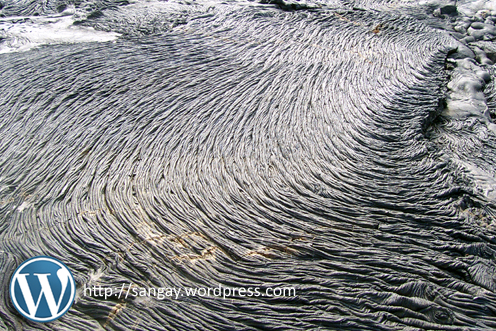 Two main types of subaerial basaltic lava have been distinguished;Pahoehoe (which is the Hawaiian word meaning ropey) which is characterized by smooth, billowy, ropey and toe surfaces; and Aa (the Hawaiian name for hurt) which has a fragmented surface.
Two main types of subaerial basaltic lava have been distinguished;Pahoehoe (which is the Hawaiian word meaning ropey) which is characterized by smooth, billowy, ropey and toe surfaces; and Aa (the Hawaiian name for hurt) which has a fragmented surface.
Pahoehoe is smooth, with a twisted, or ropey texture while Aa is sharp (it hurts to walk on it). During a pahoehoe flow the outer skin of lava cools and becomes viscous. The underlying lava, however, is insulated and remains quite liquid. As it flows, it carries the cooler skin along with it, causing it to crumple and fold into twisted shapes. Early in the flow, when the lava is hotter, these twists have the appearance of ropes, but later, as it cools and becomes more viscous, the twists are shaped more like entrails. Underneath the solidifying surface, the liquid lava continues to flow, often draining out and leaving hollow cavities which later collapse.
Aa lava in general is more viscous. The outer skin tends to form a rubbley, sharp-edged surface. As the flow moves along, the surface rubble at the edge of the flow falls off of the front edge and is over-ridden. Thus, a cross-section of an aa flow reveals a rubbley surface, a solid inner layer of slowly-cooled magma, and finally a narrow zone of over-ridden rubble. The differences between pahoehoe and aa lavas are subtle, but one important aspect is the speed of flow. Flows over steeper terrain move more rapidly and tend to be of the Aa type while slower flows tend to form pahoehoe.
In Galapagos Aa flows tend to be more abundant than pahoehoe flows, but they are rare at visitor sites – for obvious reasons. One well known Aa flow can be seen on Fernandina. The best place to see a pahoehoe flow is on Santiago. Just before the turn of the century, massive lava flows covered the southern part of the island, extending from Sullivan Bay on the east side, around to James Bay on the west. Visitors who walk on the Sullivan Bay flow are often profoundly affected by the seemingly endless barrenness of the lava. At Punta Moreno, on the west side of Isabela, visitors have the opportunity to walk out on a lava flow that is about 1,000 years old. It is interesting to compare the two lava flows. At Punta Moreno, the lava has been oxidized from shiny black to dull brown, and it much more broken. Stepping over the lava fragments results in loud clinking sounds (these rocks are often called “clinkers”) and there is a much greater variety of plants growing there than can be found at Sullivan Bay.
Aa and pahoehoe lava flows are common features in all the Galapagos but at Punta Espinosa (Fernandina Island) the outcrops are really spectacular.


Leave a comment